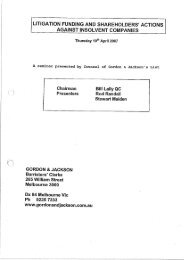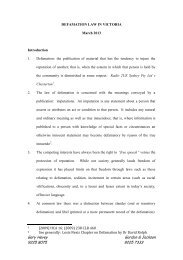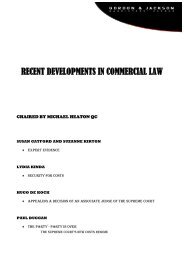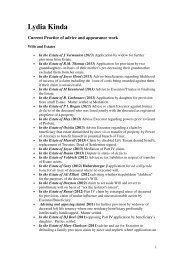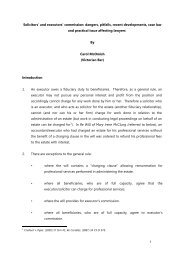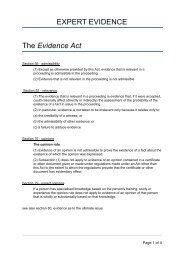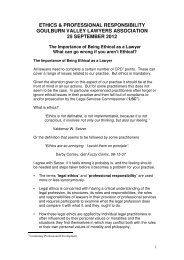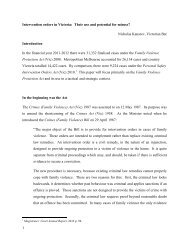CONTRACT LAW – AVOIDING LEGAL RISK WITH PRELIMINARY ...
CONTRACT LAW – AVOIDING LEGAL RISK WITH PRELIMINARY ...
CONTRACT LAW – AVOIDING LEGAL RISK WITH PRELIMINARY ...
Create successful ePaper yourself
Turn your PDF publications into a flip-book with our unique Google optimized e-Paper software.
2<br />
parties may include a confidentiality clause to aid negotiation without disclosing<br />
commercial secrets, even if no binding contractual arrangements are entered into. In<br />
this sort of situation, while no binding contractual arrangements are intended, the<br />
binding nature of the confidentiality clause is required. A negotiation may have<br />
reached a point where the parties wish to record their agreement to that point,<br />
despite other points remaining at issue 6 . A preliminary agreement may give the<br />
parties comfort and impetus for them to move towards concluding their bargain 7 .<br />
3. Preliminary agreements have proven to be a useful tool in commercial life for lawyers<br />
and business people alike 8 . Used sensibly they will assist commercial parties in<br />
reaching, and recording, a preliminary consensus, but used badly, or in an<br />
haphazard or ill-informed fashion, they can create difficulties. If the parties are<br />
ambivalent or ambiguous in their communications, problems may easily arise. Unless<br />
great care is taken to properly record the parties’ true intentions (and even if this<br />
occurs), a risk of difficulty and dispute may arise.<br />
4. The cases are legion in which the binding nature of preliminary agreements is at<br />
issue. One academic suggests that disputes about the enforceability of preliminary<br />
commercial agreements are second only to interpretation disputes as the most<br />
litigated cases in Australia and New Zealand 9 . One may query whether parties would<br />
be better off waiting for a short period for their lawyers to draw up a formal contract<br />
which may save the parties from litigation, rather than utilizing a preliminary<br />
agreement unaided by legal advice and assistance. Commercially however, the<br />
parties may purposefully wish to leave the preliminary agreement vague, ambivalent<br />
or ambiguous so that each has an “out” or an “in” depending on what subsequent<br />
give each party comfort that a meeting of the minds has taken place; the letter might convince a third party, or<br />
someone within the organisation that the contemplated deal is viable; and it may serve as an aide memoire for<br />
the draftsperson who will draft the formal contract: see, “Letters of Intent <strong>–</strong> Are they worth it”, R Macey,<br />
(2004) 78 LIJ (No 3) 60-63.<br />
6 See, J Tarrant, Preliminary Agreements (2006) 3 UNELJ 151 at 155-156<br />
7 ibid<br />
8 It is suggested that the letter of intent or heads of agreement is the preferred option for international joint<br />
venturers in the negotiation phase by which a statement of operating principles between the participants is<br />
obtained which is subsequently supplemented by a detailed joint venture agreement, The Laws of Australia,<br />
Thomson (TLA) at [24.03.106]<br />
9 DW McLauchlan, In Defence of the Fourth Category of Preliminary Agreements: Or are there only two? (2005)<br />
21 JCL 286, p 287



